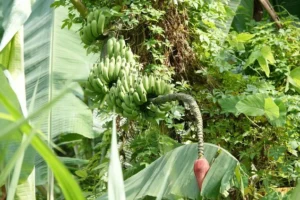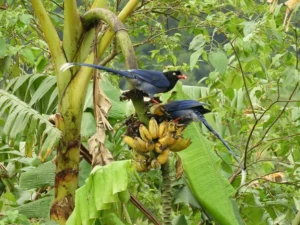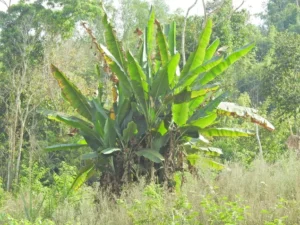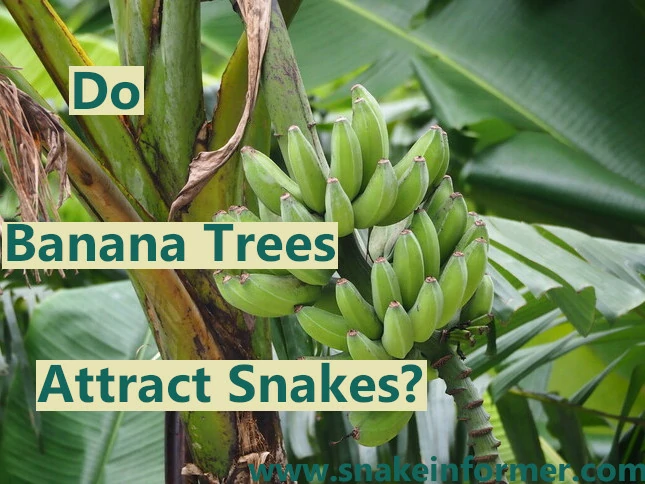Banana trees are large, fast-growing plants known for their broad, lush leaves. These plants are a common sight in many parts of the world, especially in warm regions,
Banana trees themselves don’t directly attract snakes. However, they can create an environment that’s appealing to snakes.
The large leaves of banana trees create cool, shaded spots for snakes to hide. Fallen bananas attract rodents, which snakes eat, and the dead leaves around banana trees provide cover for snakes to hunt.
Snakes in general, are very opportunistic and tend to be attracted to any area where they can hide, stay warm/cool, and find food.
Banana trees simply create the environment that snakes love.
Banana Trees Don’t Lure Snakes Directly
As mentioned earlier, snakes are not inherently attracted to banana plants themselves.
Snakes are obligate carnivores, which means their diet is entirely made up of animal products.
They do not eat bananas, or any other plants.

What draws snakes to banana growing areas, is the ecosystem that naturally develops around the trees.
3 Reasons Why Snakes Are Drawn to Banana Trees
Here are 3 reasons why snakes are drawn to banana trees:
1. Banana Trees Provide Shelter
Banana plants grow in tight clusters, with massive paddle-shaped leaves.
This results in a dense multilayered canopy that blocks much of the sunlight from reaching the ground below.
Also, the accumulation of fallen leaves and plant debris creates a layer of ground cover – which traps moisture. This means the ground stays cool and moist.
These conditions are ideal for snakes because they offer shelter from predators, protection from direct sunlight, and a good location for ambushing prey.
2. Abundance of Prey
Banana plants often drop ripe or damaged fruit to the ground.
These fallen bananas quickly attract rodents, birds, and bugs which feed on the fruits.
The abundance of bugs then draws in frogs, toads, and lizards which feed on the bugs.

This concentration of small animals attracts snakes, especially species that prey on rodents, birds, or reptiles.
Snakes in general, are very opportunistic and will be drawn to any area where they can find a reliable source of food.
Once a snake learns that an area provides easy prey it may return repeatedly, even after being removed.
3. Water and Humidity
Banana trees require lots of water to thrive. For this reason, they planted near natural water sources such as rivers, streams, or ponds.
In agricultural settings, banana plantations are often equipped with irrigation systems to ensure the soil remains consistently moist.
These water-rich areas attract a wide range of amphibians and become a natural hunting ground for amphibian-eating snakes.
Worldwide, many snakes primarily feed on amphibians and rodents.
For example, in North America, the primary food of the eastern hognose snake is toads.
In fact, Eastern hognose snakes are so specialized in eating toads, that they have large teeth in the back of their mouths to puncture inflated toads to make them easier to swallow.
Garter snakes are also heavily reliant on frogs, toads, salamanders, and newts as food.
Asian Keelback snakes also very frequently eat frogs and their tadpoles.
Do Snakes Live In Banana Trees?
Unlike birds or insects that may nest or burrow directly into banana trees, snakes don’t usually live in the actual banana tree itself.
Instead, they can be found:
- Among the roots or base of the plant: The root system and leaf litter provide protection from predators. They also act as temporary shelters, especially in hot or dry weather.
- Coiled in dense foliage: Tree-dwelling snakes may rest coiled along the leaf stems or hidden among the foliage. These snakes use their coloration and agility to blend in with the leaves, making them difficult to spot unless they move.
- In plantation areas: Large banana plantations can provide ideal conditions for snakes to thrive undetected due to the repetitive planting and shaded areas.
Snakes Commonly Found Near Banana Trees
Depending on where you live, many snake species can be attracted to your banana trees.
Here are a few snakes that are commonly found near banana trees.
Snake Type |
Description |
|---|---|
| Rat Snakes | Rat snake are common in farms, gardens, and plantations with an abundance or rodents. While harmless to humans, their presence can alarm people unfamiliar with their ecological functions, such as natural rodent control. |
| Pythons | Native to warm, humid regions like Africa and Southeast Asia. Tropical banana plantations are attractive to pythons, particularly in undisturbed environments. |
| Vine Snakes | Vine snakes are slim, tree-dwelling snakes with excellent camouflage. They often rest or hunt in the foliage of tall, dense banana plants. |
| Cobras or Vipers | Some cobras and vipers may inhabit banana plantations, especially in South Asia, Africa, or Southeast Asia. Cobras may seek cover at the base of plants, while vipers often remain hidden in leaf litter, using ambush tactics to hunt. |
5 Tips to Keep Snakes Away From Your Banana Trees
If you want to stop snakes from coming to your banana trees, you have to make the area less attractive to them.
Here are a number of things you can do to keep snakes from your banana trees.
1. Clear Fallen Fruit and Leaves
Maintaining cleanliness around banana trees is one of the most effective ways to discourage snakes from coming to the area.
Frequently removing fallen fruit or overripe bananas, helps prevent the attraction of rodents, insects, and other small animals that snakes feed on.
Dead leaves that accumulate around the base of banana plants create thick layers of organic litter.
This buildup can create cool, dark, and moist pockets, making ideal hiding places for snakes seeking shelter.
By keeping the ground clear and clean, you reduce shelter and food availability, making the environment less attractive for snakes.
2. Reduce Hiding Places
Tall grass, overgrown vegetation, and piles of rocks or logs provide the perfect cover for snakes to hide in.
They also attract mice and other small animals that snakes prey on.
It’s important to keep the area around banana plants open.

Regularly mow tall grass, remove rock piles and other debris, and clear any dense vegetation that grows close to the base of banana plants.
Creating open space reduces the number of places where snakes can hide, and makes the area less inviting to them.
3. Control Rodent and Insect Populations
One of the easiest ways of keeping snakes away is to get rid of the “snake food” (prey animals) you have in or around your banana trees.
You can do this by getting rid of trash piles, or anything that may attract rodents or insects.
Ensure that food scraps are disposed of properly, as rats and mice are attracted to places where they can find food.
Also, avoid leaving uneaten pet food outdoors, and consider storing any bird seed in rodent-proof containers.
You could also use rodent traps placed around the banana plants, especially in areas where you frequently see rodents.
To control insect populations, use natural insecticides like neem oil, and get rid of standing water that can act as a breeding ground for many insects.
In essence, make sure there is nothing in or around your yard or garden, that can attract mice or other animals that snakes prey on.
4. Trim and Space Your Banana Plants
Banana plants grow in tight clusters that provide ideal cover for snakes.
It’s important to regularly trim your banana plants and remove excess suckers.
Also, space your plants to reduce shade and create open areas – that make it easy to see any snakes or other small animals that get near.
5. Install a Fence Around Your Banana Plants
In small gardens, you can install fine mesh fencing around banana plants or even the entire garden.
This fencing will act as a physical barrier and block off any snakes that may be attracted to your plants.
It’s recommended to combine physical barriers, with other types of habitat control (eg, keeping the grass short, getting rid of rodents, etc).
This creates a multilayered “snake prevention system“
Conclusion
Snakes are not specifically attracted to banana plants.
They are attracted to any area where they can hide, stay cool, and easily find food.
Banana plants with their dense growth pattern just happen to create the environment that snakes love.
With good maintenance, you can prevent your banana trees from turning into a safe haven for snakes.
Sources:
Aeberli, Aaron & Phinn, Stuart & Johansen, Kasper & Robson, Andrew & Lamb, David. (2023). Characterisation of Banana Plant Growth Using High-Spatiotemporal-Resolution Multispectral UAV Imagery. Remote Sensing. 15. 679. 10.3390/rs15030679.
Hi, my name is Ezra Mushala, i have been interested animals all my life. I am the main author and editor here at snakeinformer.com.

